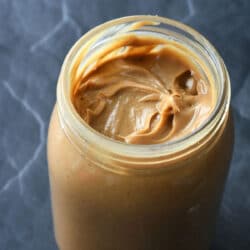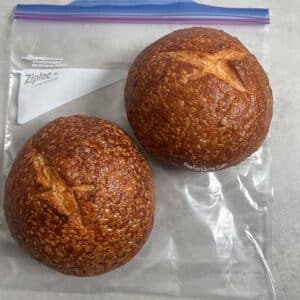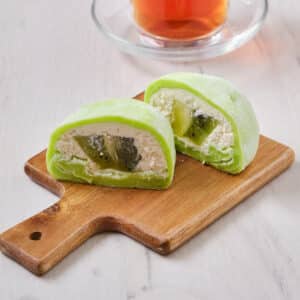Ignoring whether it is true, there is one lingering question: Can you freeze peanut butter? A similar question persists in the minds of those who take longer to empty a jar of peanut butter than three months.
Peanut butter sold in the grocery store has a shelf life of one year, so there is no need to freeze it. Regardless, if you need to store the peanut butter for a while, you can do so in the refrigerator. It will last longer this way, so no defrosting is required.
What can be done to increase the shelf life of peanut butter?
So can you freeze peanut butter? The short answer is yes. If you freeze peanut butter, it will keep for six months. You can get the same results by freezing it without removing its packaging. You can separate it into portions, seal it, and then freeze it as an alternative.
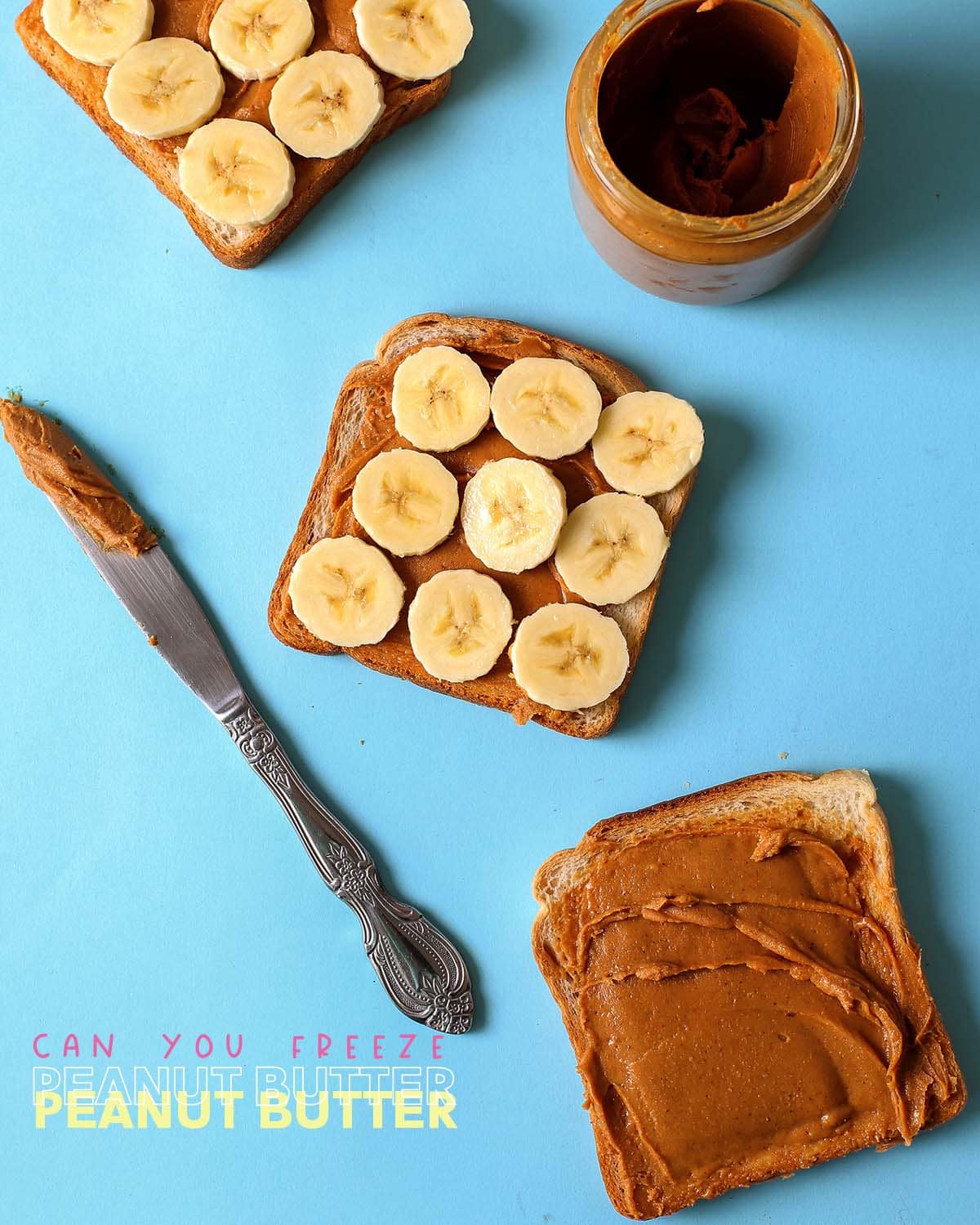
How long does peanut butter last?
No one really understands how someone can lose track of the peanut butter in the pantry for months at a time, yet it seems to happen to everyone at some point. Throwing away edible food is a waste. The question is, how long can pantry foods be stored safely without spoiling or more commonly, losing their quality?
It depends on a few factors as to how long food will remain fresh. The United States Department of Agriculture (USDA) provides information regarding food storage at home.
Temperature
Keep your foods stored in a clean, dark, and cool pantry or cupboard — ideally afar from any heat-producing appliances. Consider a pantry with a cool temperature that ranges from 50°F to 70°F. This helps food to maximize its shelf life efficiently.
On the contrary, pantry with warmer temperatures above 100°F tends to diminish the quality of many foods, particularly canned goods.
Time
In general, canned food and staples last a long time, but USDA advises consumers to buy only what they use within the expiration date. Be sure to clearly mark the date on the packaging when you store them at home, and always consume the oldest products first.
Geographic area
A geographic zone is another factor that impacts the recommended storage time. Food products stored in warm and humid temperatures can lessen their shelf life.
When you buy
Beware of products with dirty labels or dented edges, indicating old stock. The US Department of Agriculture recommends buying only cans in good condition and avoiding cans with dents or dings.
But what about peanut butter?
The way you store peanut butter has a lot of effects on its shelf life. For example, you can prolong its life if you store it in airtight containers and follow the abovementioned guidelines.
1 For an opened jar of peanut butter
Peanut butter stays fresh in the pantry for three months once opened. Subsequently, storing it in the fridge prolongs its shelf life for another 3-4 months and prevents oil separation.
2 For an unopened jar of peanut butter
The unopened peanut butter will remain fresh in the pantry for a year before its quality deteriorates. The longer it stays in the pantry, the more it is susceptible to becoming rancid as the oil breaks down. Though rancid peanut butter isn't life-threatening when consumed, the aftertaste won't be palatable.
The urgency to freeze peanut butter doesn't always occur. If it does, regardless, it should freeze well without any issue. At any rate, many will agree that it's not difficult to consume a jar of peanut butter over a span of six or nine months.
Can you freeze peanut butter?
Absolutely. If necessary, freezing peanut butter is generally not a bad idea. In most cases, peanut butter jars are empty within six to nine months, so freezing is unnecessary.
By contrast, keeping a peanut butter jar frozen will actually extend the shelf life. Make small portions of peanut butter and freeze them until solid.
In fact, you can even store peanut butter by freezing it in ice cube trays.
A brand-new jar of peanut butter that is sealed and unopened can be frozen, simply place it in the freezer.
Keeping the jar in a zip-lock freezer bag is a good idea since there is a possibility for the container to burst due to expansion without sufficient space.
How to freeze peanut butter
Various peanut butter freeze differently, so you should freeze a small sample beforehand. As a first step, put 1 tablespoon of peanut butter onto a small sheet of parchment paper. This should go in the freezer for at least two hours. Regardless of whether it freezes well, you won't waste a whole jar of peanut butter.
Step 1 Mixing before freezing
Due to its simple ingredients with no additives, homemade or natural peanut butter tends to have an oily layer on top. Ideally, gently mix it back together before freezing to ensure smooth and uniform.
You can skip the mixing step with store-bought peanut butter or commercial peanut butter. It's because commercial versions use hydrogenated oils as part of the formulation. Increasing texture, preventing oils from segregating, and extending the shelf life of oils.
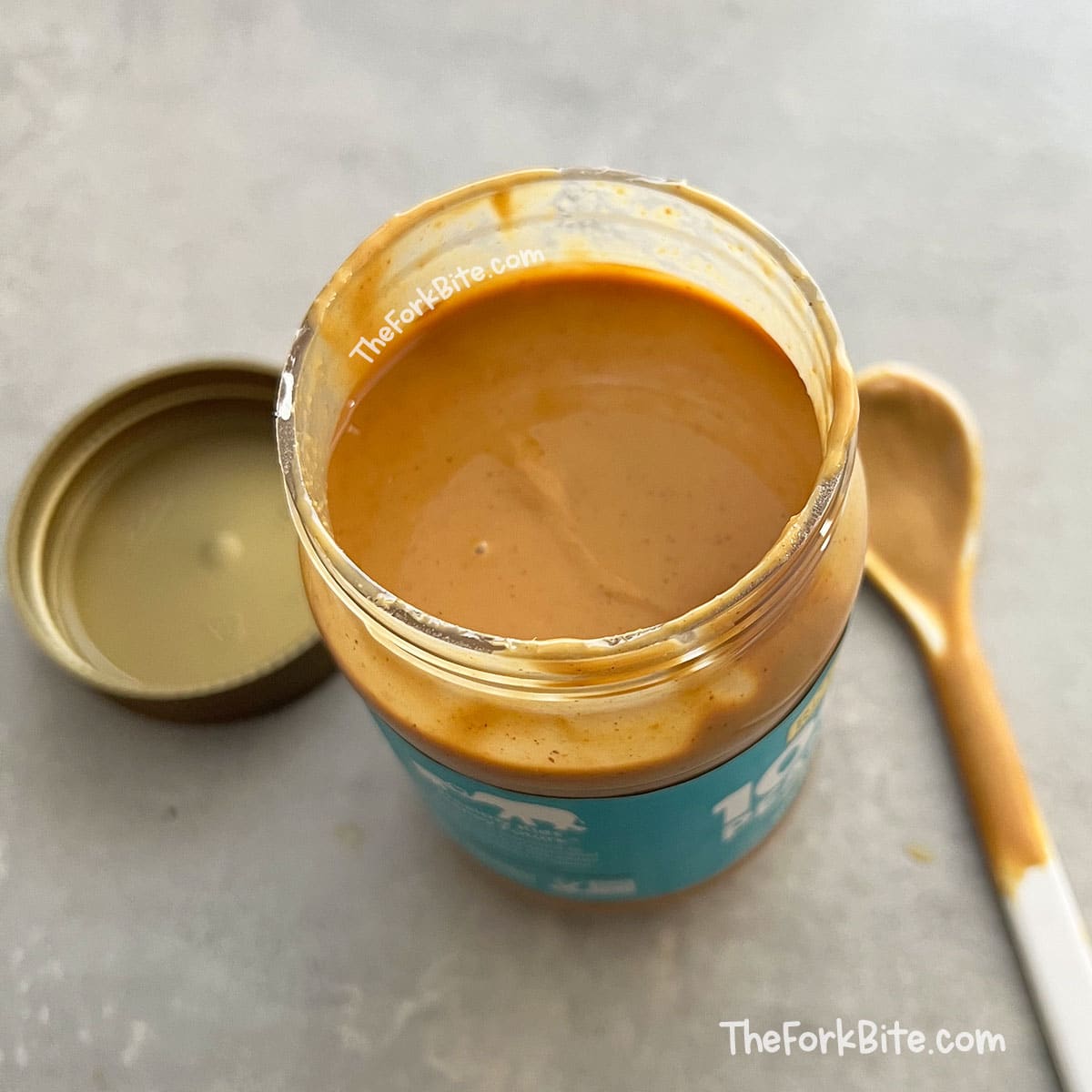
Step 2 Packaging for freezing
Here are three options for packaging and freezing peanut butter:
Option 1 Use resealable freezer bags
To use this method, spoon the peanut butter into resealable freezer bags, squeeze out any air, seal it and place the bags in the freezer. Portioning the peanut butter in separate bags would prevent wasting the entire supply by defrosting it at the same time.
Option 2 Using containers
Place the peanut butter in airtight containers suitable for freezing, allowing a small amount of headspace to accommodate freezer expansion.
Cover it with parchment paper or cling film on top as a precaution against air contact with the peanut butter. Close the container tightly. Peanut butter is more susceptible to freezer air when the container has excess headspace.
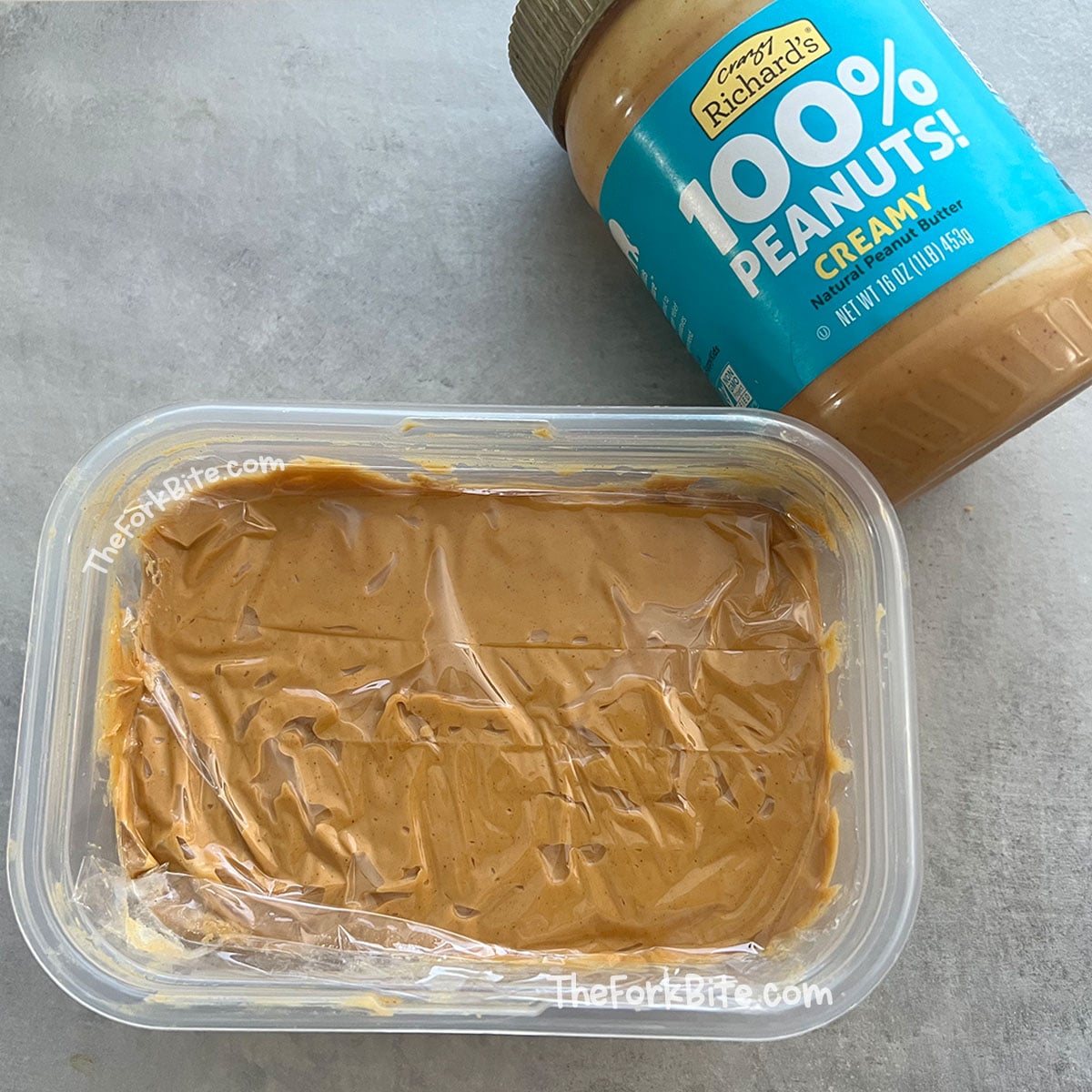
Option 3 Freezing peanut butter in an ice cube tray
Fill ice cube trays with peanut butter and freeze them to make smaller servings. Tap the tray to release the air bubbles, wrap the tray in plastic, and flash freeze for one or two hours. After they have frozen solid, you can transfer them into a resealable plastic bag. For those of you with young children, this is an excellent method.
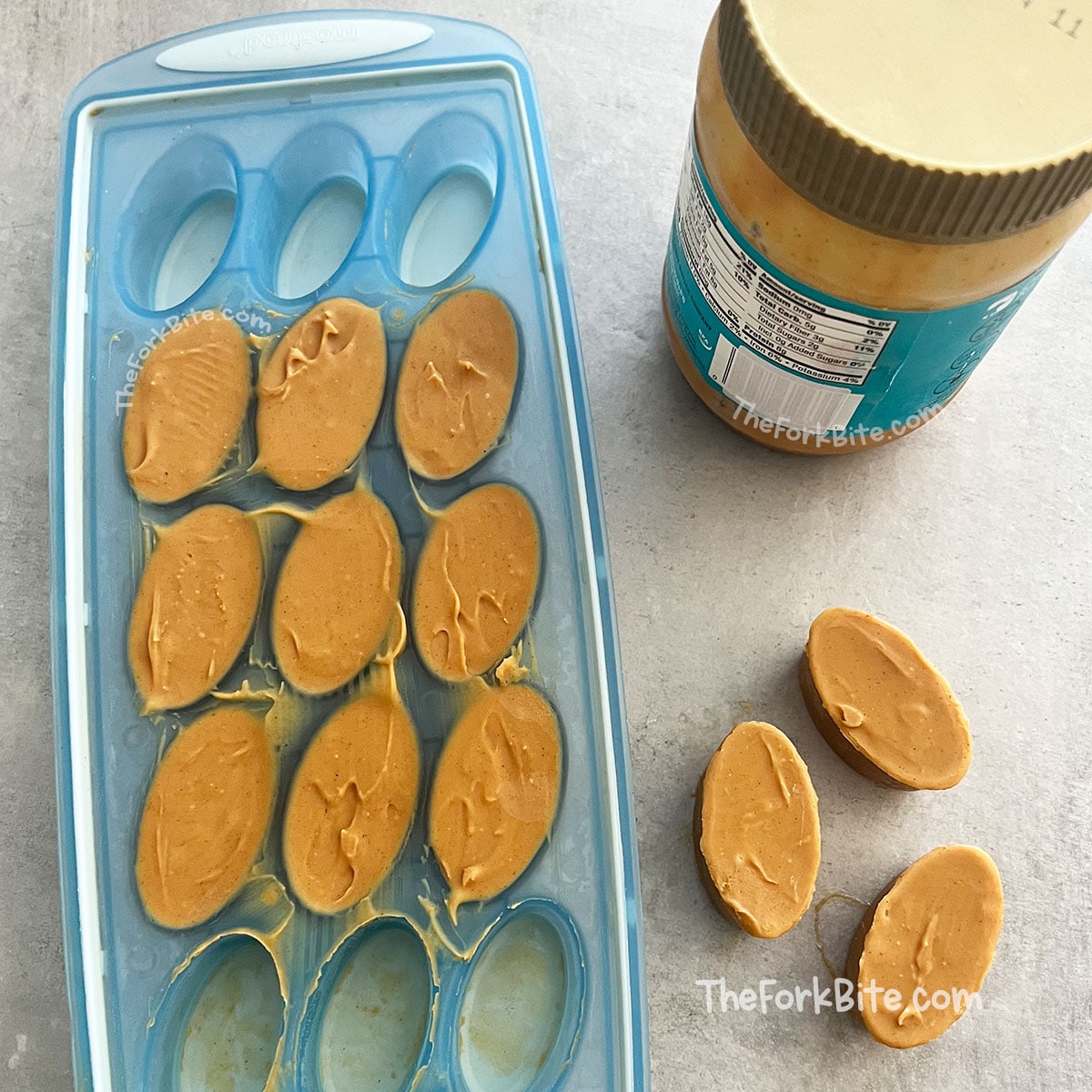
Benefits of using ice cube trays
The cubes are not only fun for kids; you can easily remove peanut butter only when needed. In addition, a cube is a ready-to-use serving, sufficient for a sandwich, making it easy to blend into a smoothie.
A resealable freezer bag also allows you to store the ice cubes of peanut butter for a more extended period for later use. Transfer the cubes to the bags quickly, as they are prone to instantly melting.
Step 3 Label before freezing
The best practice involves writing the date on the freezer bag or container, then placing it in the freezer.
Extra tips for freezing peanut butter
In addition to knowing how to freeze peanut butter, you should consider the following tips for optimal results:
1 Peanut butter tubs are better for freezing than glass jars.
Choose plastic or tub containers instead of glass jars whenever you plan to freeze peanut butter. Consequently, there is no need to transfer peanut butter between containers because plastic tubs can go directly into the freezer.
2 Ice cube trays make small servings.
As far as freezing peanut butter in small amounts, you may want to freeze it first in ice cube trays and then transfer it to a freezer bag to preserve it for a long time. Smoothies made with peanut butter taste great, or you might like to keep some on hand for other reasons.
3 Serve in small portions
Divide your peanut butter into small servings into airtight containers or freezer bags. The smaller the portions, the faster the peanut butter will freeze.
You can freeze peanut butter more effectively by covering its surface with plastic wrap or wax paper. Using a heavy-duty freezer bag, remove all the air before freezing.
4 Close and store the airtight container in the freezer.
A label on your container that tells you when to put the peanut butter in the freezer assures you to use it before it expires. It's easy to forget which batches should be thawed first after things have been frozen for some time.
Note:
The freezing point of all-natural peanut butter (which contains only peanuts) is 37°F (3°C). Adding additional ingredients to peanut butter makes it harder to predict its freezing point as they influence its freezing point and its freezing rate.Does peanut butter freeze well?
Yes, peanut butter freezes well, without any adverse side effects on the taste or texture once frozen. There will be some splitting during the freezing-thawing cycle, but it's nothing a little stirring cannot remedy!
Many people prefer buying it in bulk for freezing purposes as big peanut butter tubs are cheaper than individual jars.
You can also freeze natural peanut butter in any shape you want. Nut butter with additives like stabilizers and preservatives may not freeze solid, but freezing will help preserve it.
Is it possible to refreeze peanut butter?
Yes, as long as you thaw it in your fridge, it is okay to refreeze peanut butter. Through my experience, I have learned that refrozen peanut butter has a great taste without any textural changes.
It is, however, vital that you store the peanut butter in an airtight container for refreezing. If not, the peanut butter may develop lots of frosts, making it even more challenging to refreeze.
Instead of refreezing the peanut butter, I recommend portioning it as required before freezing so that you can remove and use it as much as needed.
How to thaw peanut butter?
Thawing overnight in the fridge is the best practice for safety. Indeed, this process may take a bit longer but is worth the effort.
If you accidentally thaw peanut butter on the counter, it would result in condensation on the outside and probably inside. Though nobody likes that, however, you don't need to be alarmed.
The main concern is that peanut butter will separate if thawed at warm or even at room temperature. This occurrence results from using natural or homemade peanut butter that uses one ingredient, like peanuts.
Sure thing, you can thaw peanut butter at the counter if you need it immediately, but you must have a watchful eye on it.
1 Thawing pure or natural peanut butter
Be ready to see frozen pure natural peanut butter separate while thawing, just like the oil and butter emulsion formed while in storage. This natural process is called syneresis, where oils and solids separate with increased temperature.
Popping and thawing the butter in the refrigerator may take time but reduces the process. However, you do not have to worry about peanut butter and oils separating, and the PB will still be palatable.
All you have to do is mix it using a sandwich spreader and create a churning motion for a few minutes, to create a smooth paste before it is ready to use.
2 Thawing other kinds of peanut butter
Store-bought commercial peanut butter contains stabilizers and additives to extend its shelf life and prevent oil separation. These are the type of peanut butter that you can thaw safely on the kitchen counter.
a.) Thawing a whole jar of peanut butter
When it's time to use the whole jar of frozen butter, you can gently defrost it inside the fridge overnight. Take off the lid while thawing and put it back once the entire container is unfrozen.
b.) Thawing small portions
If you want to thaw a small portion of PB, just place it on a dish on the countertop. You can also add the frozen discs into the center if you use the small disc method to fill cookies.
However, never use the microwave to thaw your peanut butter. The heat will burn the oils and could trigger possible health problems. And in the case of recipes that require PB, add it to the hot dish and let its heat gently defrost it.
If you are in a hurry, you can try this trick to thaw the peanut butter quickly.
- Try placing the sealed container in a bowl of warm water. The warm water temperature is more than enough to heat and helps thaw the peanut butter safely.
How long does peanut butter last in the freezer?
While you can keep peanut butter in the freezer for more than six months, extended storage longer than that can impact its flavor. PB absorbs that horrible freezer flavor over time. But as there is not much moisture in peanut butter, there's no worry about freezer burn.
Does peanut butter have an expiry date?
The peanut butter you find in supermarkets comes in a plastic jar, with a "best before" date for about 18 months after placing it on the shelf. The spread is safe to consume if unopened.
However, once opened, the rancid nut flavors it acquires over the next five or more years become so bad that even a peanut butter enthusiast will not want to touch it!
However, it is just the taste that goes bad. You can safely consume the peanut butter if you can tolerate the taste and don't have a peanut allergy.
On the contrary, as pure peanut butter does not contain preservatives and emulsifiers, its oil separates and rises to the top within a fortnight.
However, after two to three months, not only will you have to mix it before consuming it, the PB quickly gets rancid that you have no option but to throw it.
Can peanut butter go bad?
Anything and everything spoils as they have an expiry date, including peanut butter.
Nevertheless, your jar of gooey and delicious peanut butter won't spoil for at least a few months at room temperature, thanks to its low moisture and high oil content. But this does not imply that it remains fresh and that you can ignore its expiry date!
Peanut butter turns rancid and starts losing its flavor within a year thanks to oxygenation.
Peanut butter is standing proof for its theory that fatty foods are tasty foods! Just take a look at its label. You will notice that peanut butter is full of fat, containing about 16 grams in two tablespoon servings!
And it is not just natural oil to blame. Commercial peanut butter usually contains other vegetable oils like soybean, rapeseed, and cottonseed.
But don't be deceived by PB's wet and greasy looks. According to Land O' Lakes Inc's public affairs director Lydia Botham, this butter is dehydrated, with only about 2 percent moisture.
The low moisture levels in PB are because oils and fats do not mix and there is so much oil in it that there's no space for water.
But it is, thanks to its minimal water content, bacteria and fungi cannot survive in the spread. The aridness of peanut butter and other unrefrigerated goods like cereal and pasta prevent any possible corruption.
However, aridity does not mean peanut butter doesn't spoil.
Thanks to its high-fat levels, it breaks by rancidification. But do not confuse rancidification with its normal oil separation process in PB, where its fat separates from peanut butter to float at the top of the jar, which stirring resolves.
Rancidification is an entirely different chemical process where oxygen breaks down lipid molecular structure to unappetizingly change its flavor and odor. And the problem is that with the constant exposure to oxygen, there is a higher chance of PB experiencing rancidification.
And as foods turn rancid 9 to 12 months after purchase, they come with an expiry date.
Signs that peanut butter has gone off
You know that peanut butter loses its texture, odor, and flavor with time because its oils break down and turn rancid with constant exposure to oxygen. PB also contains vitamin E, which acts as a natural antioxidant to slow down the rancidification process and keep PB longer on shelves than other fats.
- Your peanut butter is spoiled if it gets dry, hard, and dark brown instead of its normal creamy, soft, and light brown consistency.
- Another sign of spoiled peanut butter is the change in smell. Rancid peanut butter starts smelling sharp, bitter, or soapy instead of the typical salty, nutty odor. You will not get ill eating rancid peanut butter, but you may not enjoy its taste.
- Always check for signs of mold and dispose of it if it has mold.
3 Useful tips for storing peanut butter
Yes, there are many other ways to store peanut butter than freezing! With the right storage conditions, processed peanut butter can last up to a year, and pure peanut butter, up to three months.
1 Cool and dry conditions
Ideally, you can store peanut butter someplace cold and dry, like in your pantry, at an ideal temperature of 10°C or lower. Anything colder makes the PB hard, thus making spreading difficult, while PB quickly turns rancid in warmer temperatures like room temperature.
You can store the peanut butter with other vegetables like potatoes, carrots, and onions while enduring there is no moisture in the pantry.
2 Time needed to finish one jar
Think how much time you need to empty an entire jar of peanut brittle before buying one. It depends on how often you consume it if you have a big or small family, and how many of you love and hate peanut butter.
It does not matter how or where you store your peanut butter if you finish a jar in a week, as it won't go bad so quickly. However, if you are not precisely a peanut butter fan, you may want to store it somewhere cool or in the fridge.
3 Consume the peanut butter within a year of opening
No matter how quickly or rarely you eat PB, I recommend you throw any opened jar within a year of opening. Open peanut butter jars are exposed more to oxygen, and with time and temperature fluctuations, this quickens the oils and fats rancidification process.
You need to consume natural peanut butter even quicker as it will not even last this long! So while you should not keep opened peanut butter for years, unopened jars last longer, sometimes longer than the label printed expiry date.
Related asked questions
Yes, you can lose weight by eating peanut butter while on a balanced and healthy diet. BUT it all depends on how much PB you consume as it is high in calories and fats. So be careful of your serving sizes.
If on a diet, I recommend eating 100% natural peanut butter as it doesn’t contain added sugars and oils. Reasonable amounts of high-quality peanut butter help with your diet.
Besides, peanut butter satiates you for longer, thanks to its high protein and healthy fat content. You can also safely use it to replace your favorite unhealthy treats without worrying about blood sugar fluctuations.
Yes, you can give your dog PB. And about how much you can safely give, it depends on how much your dog can enjoy it.
Unfortunately, most pet owners do not measure their pets’ calories. If you feed your dog peanut butter, measure and ensure it does not constitute more than 10% of its everyday food requirements.
This equals about half a tablespoon for small dogs and a full or slightly more tablespoon of peanut butter for larger dogs. And it is always better if your peanut butter contains only peanuts, as it means the PB contains no xylitol.
Peanut butter is safe for babies but can be very dangerous for those with peanut allergies. The problem is that you will not know if your baby is allergic to these nuts without trying.
You will want to be confident and know that it’s safe to feed your baby peanut butter.
Babies with other health conditions and allergies to other food items like eggs have a higher risk of peanut allergy.
You must know if your baby tolerates peanuts or not. I suggest starting it in a safe and controlled environment like your doctor’s or allergist’s office. And the best way to find out is by slowly introducing it to them.
If you know your baby doesn’t have any allergies, you can give them peanut butter at about 4 to 6 months old. It’s not recommended to feed peanut butter as it is because your baby may choke on it. Instead, smoothen the peanut butter by adding water, if necessary, before feeding.
While peanuts can lead to choking, PB is also risky for babies as it is very sticky. So I advise you not just to feed your baby peanut butter. Keep monitoring them the first few times you feed them PB to see if they can swallow it without any problems.
There is a chance of them developing symptoms like red eyes, runny nose, and signs of swelling and irritation. While it is normal for babies to have runny noses, keep a watchful eye on your baby for other signs or changes.
How to Freeze Peanut Butter (How-to instructions)
Pin RecipeIngredients:
- leftover peanut butter
Instructions:
STEP 1: Mixing before freezing
- You have to gently mix it back to create a smooth and even consistency before freezing. You can skip the process of mixing if you have store-bought or commercial peanut butter. Its because commercial ones used hydrogenated oils prevent the separation of oils, improving texture and extending its shelf life.
STEP 2: Packaging for freezing
- You can choose between three ways to package and freeze the peanut butter:
Option 1: Using resealable freezer bags
- Scoop and empty the peanut butter into resealable freezer bags, press out the remaining air, seal, and freeze. It’s even more convenient if you place it in different bags to defrost only one batch at a time when required.
Option 2: Using containers
- Scoop the peanut butter into airtight, freezer-friendly containers and freeze. Always leave a bit of space on the top of the butter for expansion while freezing. However, do not leave too much space as excessive headspace exposes the peanut butter to lots of cold, freezing air. Note: Placing some parchment paper or cling film on the top of the peanut butter before sealing protects against any possible air contact.
Option 3: Using ice cube
- You can make peanut butter cubes by scooping the peanut butter into an ice cube tray and freezing. Once again, press out the air before sealing.
STEP 3: Label and Freeze
- Put a label the date. Place it on the peanut butter container before freezing.
Notes:
Extra tips for freezing peanut butter
In addition to knowing how you can freeze peanut butter, these three tips give you the best-frozen spread.1 Peanut butter tubs are better for freezing than glass jars.
Peanut butter tubs or plastic containers are easier for freezing as you just have to place them in the freezer. There is no need first to switch your peanut butter to another container. So avoid buying glass jars if you know you will be freezing the nut butter.2 Ice cube trays make small servings.
For those who need small servings of peanut butter for smoothies or other purposes, freeze it in ice cube trays. You can always transfer the cubes into a freezer-safe bag and store them for as long as you need. To freeze the peanut butter quickly, portion it into airtight containers or heavy-duty freezer bags. These smaller portions offer an additional benefit of freezing faster. The peanut butter freezes better in airtight containers if you place a layer of plastic wrap or wax paper on its surface. Squeezing out all the freezer bag air also helps.3 Close and store the airtight container in the freezer.
If you are someone who does a lot of freezing, then it is better to label the container with the date of freezing. This way, you know which batch to use first and, in the process, reduce the chances of ending up with old, untouched peanut butter.Please note that all nutrition information are just estimates. Values will vary among brands, so we encourage you to calculate these on your own for most accurate results.

